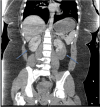Bilateral Renal Infarcts Due to Blunt Trauma in a Healthy Young Female Patient: A Case Report
- PMID: 40458362
- PMCID: PMC12127146
- DOI: 10.7759/cureus.83366
Bilateral Renal Infarcts Due to Blunt Trauma in a Healthy Young Female Patient: A Case Report
Abstract
Bilateral renal infarcts due to blunt trauma in the absence of underlying pathology are a rare condition. Trauma-induced renal infarction occurs due to decreased perfusion to the renal system. A 23-year-old woman with no significant past medical history presented to the emergency department with abdominal pain after being struck by a car as a pedestrian. She reported abdominal pain, shoulder pain, and pelvic pain. Imaging revealed multiple traumatic injuries, including a right shoulder dislocation, vertebral and pelvic fractures, and bilateral renal infarcts. Extensive workup, including echocardiography, renal ultrasound, magnetic resonance angiography, and hypercoagulability testing, was unremarkable. The findings were attributed to transient renal hypoperfusion secondary to trauma-related vascular dysfunction. Her symptoms resolved with conservative management, and she was discharged with outpatient follow-up. Renal infarcts are most commonly due to cardioembolic events, and trauma-induced renal infarcts are rare and typically result from hypoperfusion, vasospasm, or vascular injury. Contrast-enhanced CT imaging is used to diagnose renal infarcts. Most trauma-related cases of renal infarcts resolve spontaneously without any complications. This case highlights a rare instance of bilateral renal infarction after blunt abdominal trauma. Further research is warranted to discuss the clinical significance of and long-term outcomes of transient renal hypoperfusion in trauma patients.
Keywords: abdominal blunt trauma; bilateral renal infarcts; hypoperfusion; renal injury; trauma-related vascular injury.
Copyright © 2025, Locklear et al.
Conflict of interest statement
Human subjects: Consent for treatment and open access publication was obtained or waived by all participants in this study. Conflicts of interest: In compliance with the ICMJE uniform disclosure form, all authors declare the following: Payment/services info: All authors have declared that no financial support was received from any organization for the submitted work. Financial relationships: All authors have declared that they have no financial relationships at present or within the previous three years with any organizations that might have an interest in the submitted work. Other relationships: All authors have declared that there are no other relationships or activities that could appear to have influenced the submitted work.
Figures



References
-
- Clinical characteristics and outcomes of renal infarction. Oh YK, Yang CW, Kim YL, et al. Am J Kidney Dis. 2016;67:243–250. - PubMed
-
- ED presentations of acute renal infarction. Huang CC, Lo HC, Huang HH, et al. Am J Emerg Med. 2007;25:164–169. - PubMed
-
- Scuderi M, Mannino M, Schembari E, Terranova W, Urzia V. Imaging in Nephrology. Cham: Springer; 2021. Renal traumas in nephrologic patients; pp. 125–133.
-
- CT features of renal infarction. Suzer O, Shirkhoda A, Jafri SZ, Madrazo BL, Bis KG, Mastromatteo JF. Eur J Radiol. 2002;44:59–64. - PubMed
Publication types
LinkOut - more resources
Full Text Sources
Miscellaneous
